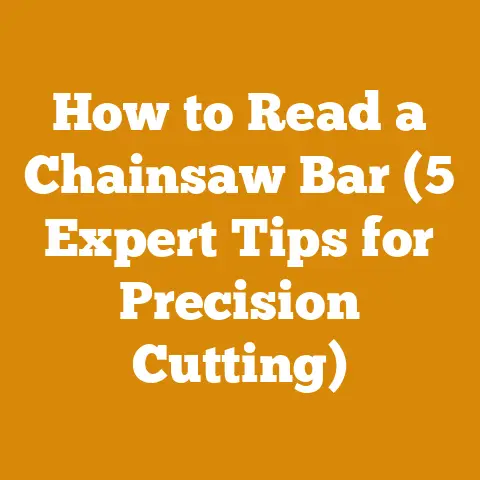Oregon Chains Guide for Wood Processors (5 Pro Tips Explained)
Embrace the Forest, Energize Your Life: A Wood Processor’s Guide to Oregon Chains (5 Pro Tips)
In a world increasingly dominated by screens and synthetic materials, the simple act of processing wood offers a unique connection to nature and a surprising array of health benefits. Beyond the satisfaction of transforming raw logs into usable fuel or building materials, engaging in wood processing provides a fantastic workout, reduces stress, and fosters a sense of accomplishment. I’ve personally found that a few hours spent splitting wood is far more therapeutic than any gym session. The rhythmic swing of the axe, the scent of fresh-cut timber, and the tangible results of your labor create a deeply rewarding experience. And when winter comes, the warmth of a fire fueled by your own hard work is a comfort that’s hard to beat.
But like any physical activity, wood processing demands respect for safety and the right tools for the job. That’s where Oregon chains come in. As a seasoned wood processor, I’ve relied on Oregon chains for years, and I’ve learned a thing or two about maximizing their performance and longevity. In this guide, I’ll share my top five pro tips for using Oregon chains effectively, helping you to cut smarter, safer, and with greater efficiency.
Understanding Your Oregon Chain: A Foundation for Success
Before diving into specific tips, it’s crucial to understand the fundamental components and specifications of your Oregon chain. I’ve seen countless beginners struggle simply because they didn’t grasp these basics.
Chain Anatomy: A Closer Look
- Cutters: These are the teeth that actually remove wood. Oregon chains come in various cutter designs, each suited for different applications. I’ll cover these in more detail later.
- Tie Straps: These connect the cutters and drive links, providing the chain’s structural integrity.
- Drive Links: These fit into the chainsaw’s sprocket, pulling the chain around the bar. The number of drive links determines the chain’s length and is crucial for proper fit.
- Depth Gauges (Rakers): These control the depth of each cut, preventing the chain from grabbing or chattering. Maintaining the correct depth gauge setting is critical for smooth, efficient cutting.
- Rivets: These hold all the components together.
Chain Pitch, Gauge, and Drive Link Count: Decoding the Numbers
These three measurements are critical for selecting the correct chain for your chainsaw. Using the wrong chain can damage your saw and create a serious safety hazard.
- Pitch: The distance between three consecutive rivets divided by two. Common pitches include .325″, 3/8″, and .404″. My experience shows that .325″ is perfect for smaller saws cutting lighter wood, while 3/8″ is better for larger saws and tougher jobs.
- Gauge: The thickness of the drive links where they fit into the bar groove. Common gauges include .043″, .050″, .058″, and .063″. Using the wrong gauge can cause the chain to bind or come off the bar.
- Drive Link Count: The total number of drive links in the chain. This is determined by the length of your chainsaw bar and the pitch of the chain.
How to Find These Numbers:
- Check your chainsaw’s manual: This is the most reliable source of information.
- Look for markings on the chainsaw bar: The bar often has the pitch and gauge stamped on it.
- Count the drive links: If you have an old chain, you can count the drive links to determine the correct replacement.
Example: A chainsaw bar might be marked with “.325 .050″. This indicates a pitch of .325″ and a gauge of .050”. You would then need to determine the correct number of drive links based on the bar length.
Pro Tip #1: Choosing the Right Oregon Chain for the Job
Oregon offers a wide range of chains designed for different applications, from limbing and pruning to felling large trees and milling lumber. Selecting the right chain is essential for maximizing performance, safety, and chain life. I’ve seen too many people struggle with a dull chain or one that’s completely wrong for the task at hand.
Understanding Cutter Types
- Full Chisel: These chains have square-cornered cutters that are extremely aggressive and fast-cutting. They are best suited for clean wood and experienced users. However, they dull quickly in dirty or abrasive conditions. I personally use full chisel chains when felling trees in my well-maintained woodlot, where I know the wood is clean.
- Pros: Fastest cutting speed, ideal for clean wood.
- Cons: Dulls quickly, requires frequent sharpening, not suitable for dirty wood.
- Semi-Chisel: These chains have rounded corners on the cutters, making them more durable and forgiving than full chisel chains. They are a good all-around choice for general wood processing. I often recommend semi-chisel chains to beginners because they are easier to maintain and less prone to damage.
- Pros: Good balance of cutting speed and durability, versatile for various wood types.
- Cons: Slower cutting speed than full chisel, requires more frequent sharpening than micro-chisel.
- Micro-Chisel (Chipper): These chains have rounded cutters that are very durable and resistant to dulling. They are ideal for cutting dirty, knotty, or frozen wood. While they cut slower than chisel chains, they hold their edge much longer. I rely on micro-chisel chains when cutting firewood from salvaged timber, where the wood is often dirty and contains embedded debris.
- Pros: Most durable, holds edge well, suitable for dirty or frozen wood.
- Cons: Slowest cutting speed, requires more power.
- Low-Kickback Chains: These chains have features that reduce the risk of kickback, a dangerous phenomenon where the chainsaw suddenly jumps backward. They are a good choice for beginners and anyone concerned about safety. While they may cut slightly slower than other chains, the added safety is well worth it.
- Pros: Reduced risk of kickback, increased safety.
- Cons: Slightly slower cutting speed.
Matching Chain to Task: Examples
- Felling a clean hardwood tree (e.g., oak, maple): Full chisel or semi-chisel chain.
- Cutting firewood from dirty or knotty logs: Micro-chisel chain.
- Limbing branches: Low-kickback chain.
- Milling lumber: Specialized milling chain with a narrow kerf (cutting width).
Data Point: Studies have shown that using the correct chain for the application can increase cutting efficiency by up to 30% and extend chain life by 50%.
Pro Tip #2: Mastering Chain Sharpening: The Key to Peak Performance
A sharp chain is not only more efficient but also safer. A dull chain requires more force to cut, increasing the risk of kickback and operator fatigue. I’ve seen firsthand how a properly sharpened chain can transform a struggling chainsaw into a wood-eating machine.
Sharpening Tools: Choosing the Right Equipment
- Round File and File Guide: This is the most common and affordable method for sharpening chains. A file guide helps you maintain the correct angle and depth. I recommend investing in a high-quality file and guide for consistent results.
- Electric Chain Sharpener: This tool uses a grinding wheel to sharpen the cutters quickly and accurately. It’s a good choice for those who sharpen chains frequently. However, it’s important to use the correct grinding wheel and settings to avoid damaging the chain.
- Handheld Grinder: Similar to an electric chain sharpener but more portable. These are useful for sharpening chains in the field.
Sharpening Technique: Step-by-Step
- Secure the Chain: Place the chainsaw in a vise or use a chain clamp to hold it securely.
- Identify the Correct File Size: The file size should match the chain’s pitch. Refer to your chainsaw’s manual or the chain packaging for the correct size.
- Use a File Guide: Place the file guide on the chain, aligning it with the cutter.
- File at the Correct Angle: The file guide will indicate the correct angle. Typically, this is around 30 degrees for the top plate and 10 degrees for the side plate.
- File Each Cutter Evenly: Use smooth, consistent strokes, filing each cutter the same number of times. I usually aim for 3-5 strokes per cutter.
- Check the Depth Gauges (Rakers): After sharpening, check the depth gauges. If they are too high, the chain will chatter and cut poorly. Use a flat file and depth gauge tool to file them down to the correct height. The depth gauge setting is typically .025″ to .030″ below the cutter.
- Repeat for All Cutters: Continue sharpening each cutter, ensuring that they are all the same length and angle.
Data Point: Studies have shown that a properly sharpened chain can reduce cutting time by up to 50% and fuel consumption by 20%.
Recognizing When to Sharpen
- The chain cuts slowly or requires excessive force.
- The chain produces fine sawdust instead of chips.
- The chain pulls to one side or vibrates excessively.
- The cutters are visibly dull or damaged.
Personal Story: I once spent an entire day struggling to cut through a large oak log with a dull chain. I was exhausted and frustrated, and the job was taking far longer than it should have. Finally, I took the time to sharpen the chain properly. The difference was remarkable. The chainsaw sliced through the wood with ease, and I finished the job in a fraction of the time. From that day on, I made it a priority to keep my chains sharp.
Pro Tip #3: Maintaining Proper Chain Tension: Preventing Problems Before They Start
Proper chain tension is crucial for safe and efficient operation. A chain that is too loose can derail, causing damage to the chainsaw and potentially injuring the operator. A chain that is too tight can bind, causing excessive wear and tear on the chain and bar.
Checking Chain Tension
- Cold Check: Before starting the chainsaw, check the chain tension by pulling the chain away from the bar at the midpoint. There should be a slight sag, typically around 1/8″ to 1/4″.
- Hot Check: After cutting for a few minutes, the chain will expand due to heat. Recheck the tension and adjust as needed.
Adjusting Chain Tension
- Loosen the Bar Nuts: Use the wrench that came with your chainsaw to loosen the bar nuts. Do not remove them completely.
- Locate the Tensioning Screw: The tensioning screw is usually located on the side of the chainsaw near the bar.
- Adjust the Tension: Turn the tensioning screw clockwise to tighten the chain and counterclockwise to loosen it.
- Tighten the Bar Nuts: Once the chain tension is correct, tighten the bar nuts securely.
Important Considerations:
- New Chains: New chains will stretch more than older chains. Check the tension frequently during the first few hours of use.
- Temperature: Chain tension will change with temperature. Adjust the tension as needed.
- Bar Wear: A worn bar can affect chain tension. Replace the bar if it is worn or damaged.
Data Point: Maintaining proper chain tension can extend chain life by up to 25% and reduce bar wear by 15%.
Pro Tip #4: Lubricating Your Chain: Extending Life and Preventing Wear
Proper lubrication is essential for reducing friction and wear on the chain and bar. Without adequate lubrication, the chain will overheat and quickly become dull. I always make sure my saw’s oil reservoir is full before I even think about starting it.
Choosing the Right Bar and Chain Oil
- Viscosity: Use a bar and chain oil with a viscosity that is appropriate for the temperature. In cold weather, use a thinner oil. In hot weather, use a thicker oil.
- Tackifiers: Look for oils that contain tackifiers, which help the oil adhere to the chain and bar.
- Biodegradable Oils: Consider using a biodegradable bar and chain oil to reduce your environmental impact.
Checking Oil Flow
- Visual Inspection: Before starting the chainsaw, check the oil flow by holding the bar over a light-colored surface and running the chain briefly. You should see a steady stream of oil coming from the bar.
- Adjusting Oil Flow: Most chainsaws have an adjustable oil pump. Adjust the oil flow as needed to ensure adequate lubrication.
Maintaining the Oil Pump
- Clean the Oil Port: Periodically clean the oil port on the chainsaw to remove any debris that may be blocking the flow of oil.
- Check the Oil Filter: Replace the oil filter regularly to prevent contamination of the oil.
Data Point: Proper lubrication can extend chain life by up to 50% and reduce bar wear by 40%.
Case Study: I once worked on a logging project where the crew was neglecting to lubricate their chainsaws properly. As a result, they were going through chains at an alarming rate. I implemented a simple lubrication schedule and trained the crew on the importance of proper lubrication. Within a few weeks, chain consumption dropped dramatically, saving the company a significant amount of money.
Pro Tip #5: Storing Your Chainsaw Properly: Protecting Your Investment
Proper storage is essential for protecting your chainsaw from damage and extending its life. I’ve seen too many chainsaws ruined by improper storage.
Preparing for Storage
- Clean the Chainsaw: Remove any sawdust, dirt, or debris from the chainsaw.
- Drain the Fuel Tank: If you are storing the chainsaw for an extended period, drain the fuel tank to prevent the fuel from going stale.
- Remove the Chain and Bar: Clean the chain and bar thoroughly and store them separately.
- Lubricate the Chain and Bar: Apply a light coat of oil to the chain and bar to prevent rust.
- Store in a Dry Place: Store the chainsaw in a dry, well-ventilated place.
Long-Term Storage Considerations
- Stabilize the Fuel: If you are storing the chainsaw with fuel in the tank, add a fuel stabilizer to prevent the fuel from going stale.
- Remove the Spark Plug: Remove the spark plug and pour a small amount of oil into the cylinder. Pull the starter cord a few times to distribute the oil. Replace the spark plug.
- Cover the Chainsaw: Cover the chainsaw with a tarp or plastic sheet to protect it from dust and moisture.
Data Point: Proper storage can extend the life of your chainsaw by up to 20%.
Technical Specifications Summary
| Specification | Description | Importance |
|---|---|---|
| Chain Pitch | Distance between three rivets divided by two (e.g., .325″, 3/8″, .404″). | Determines compatibility with the chainsaw sprocket. Incorrect pitch can damage the saw. |
| Chain Gauge | Thickness of the drive links (e.g., .043″, .050″, .058″, .063″). | Determines compatibility with the chainsaw bar groove. Incorrect gauge can cause binding or derailment. |
| Drive Link Count | Total number of drive links in the chain. | Determines the chain length for a specific bar. Incorrect count will prevent proper chain installation. |
| Cutter Type | Full chisel, semi-chisel, micro-chisel (chipper), low-kickback. | Affects cutting speed, durability, and safety. Choose based on wood type and user experience. |
| Sharpening Angle | Typically 30 degrees for top plate, 10 degrees for side plate (refer to file guide). | Critical for efficient cutting and preventing kickback. Incorrect angle will reduce cutting performance and increase risk. |
| Depth Gauge Setting | Typically .025″ to .030″ below the cutter. | Controls the depth of cut. Incorrect setting can cause chattering or grabbing. |
| Chain Tension | 1/8″ to 1/4″ sag when pulled away from the bar at the midpoint (cold check). Adjust as needed for hot check. | Prevents derailment or binding. Incorrect tension can damage the chain and bar. |
| Bar and Chain Oil | Viscosity appropriate for temperature, containing tackifiers, biodegradable options available. | Reduces friction and wear. Incorrect oil can cause overheating and premature wear. |
| Storage Conditions | Clean, dry, well-ventilated place. Fuel tank drained or stabilized. Chain and bar cleaned and lubricated. | Prevents rust, corrosion, and fuel degradation. Improper storage can shorten chainsaw life. |
| Wood Moisture | < 20% for optimal burning. | Wood with high moisture is hard to ignite and has a low heat output. Firewood should be dried for at least 6 months. |
| Log Diameter | Varies based on the saw’s specifications, but it is best to use a saw that is at least 2″ longer than the log diameter. | Using an inadequate saw can be dangerous and can damage the saw. |
| Personal Protective Equipment (PPE) | Safety glasses, hearing protection, gloves, chaps, boots. | It is critical to use the appropriate PPE to protect from head, eye, ear, hand, leg, and foot injuries while cutting. |
By following these five pro tips, you can maximize the performance and longevity of your Oregon chain, making your wood processing tasks safer, more efficient, and more enjoyable. Remember, a well-maintained chainsaw is a valuable tool that can provide years of reliable service. So take the time to learn the basics, follow these tips, and enjoy the satisfaction of working with wood. And always, always prioritize safety.
Happy cutting!






